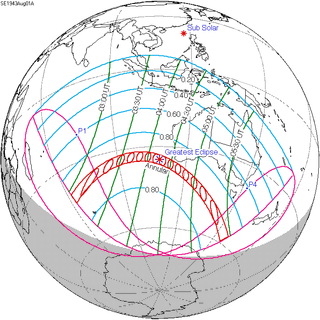| Solar eclipse of August 1, 1943 | |
|---|---|
| Type of eclipse | |
| Nature | Annular |
| Gamma | −0.8041 |
| Magnitude | 0.9409 |
| Maximum eclipse | |
| Duration | 419 s (6 min 59 s) |
| Coordinates | 34°48′S 108°36′E / 34.8°S 108.6°E |
| Max. width of band | 367 km (228 mi) |
| Times (UTC) | |
| Greatest eclipse | 4:16:13 |
| References | |
| Saros | 125 (50 of 73) |
| Catalog # (SE5000) | 9383 |
An annular solar eclipse occurred at the Moon's ascending node of orbit on Sunday, August 1, 1943,[1] with a magnitude of 0.9409. A solar eclipse occurs when the Moon passes between Earth and the Sun, thereby totally or partly obscuring the image of the Sun for a viewer on Earth. An annular solar eclipse occurs when the Moon's apparent diameter is smaller than the Sun's, blocking most of the Sun's light and causing the Sun to look like an annulus (ring). An annular eclipse appears as a partial eclipse over a region of the Earth thousands of kilometres wide. Occurring only about 25 minutes before apogee (on August 1, 1943, at 4:40 UTC), the Moon's apparent diameter was smaller.[2] Apogee did occur as the eclipse was just before its greatest eclipse.
Annularity was visible in the southern Indian Ocean, with the only land being Île Amsterdam in French Madagascar (now belonging to French Southern and Antarctic Lands). A partial solar eclipse was visible from Australia, Indonesia, Malaysia, eastern Madagascar, Antarctica's Wilkes Land.
- ^ "August 1, 1943 Annular Solar Eclipse". timeanddate. Retrieved 4 August 2024.
- ^ "Moon Distances for London, United Kingdom, England". timeanddate. Retrieved 4 August 2024.
